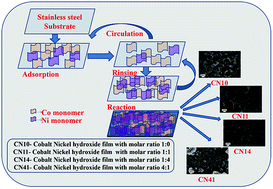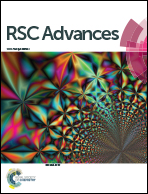Facile synthesis of amorphous Co/Ni hydroxide hierarchical films and the study of their morphology and electrochemical properties
Abstract
Amorphous Co/Ni hydroxide films were prepared by using a successive ionic adsorption and reaction method (SILAR) on a stainless steel substrate and their electrochemical properties were examined for supercapacitor application. The amorphous nature of the film was confirmed by powder X-ray diffraction. The vertically aligned interconnected nano sheet array morphology with uniform distribution was observed using scanning electron microscopy and atomic force microscopy. Their electrochemical properties were measured by performing cyclic voltammetry, galvanostatic charge–discharge and electrochemical impedance spectroscopy studies in an aqueous electrolyte. The specific capacitance was calculated to be 720 F g−1 at 5 mV s−1 for Co/Ni hydroxide, which shows a substantial improvement in electrochemical capacitance as compared to the pure cobalt hydroxide. The result suggested that the template free deposition method is a promising method for achieving next generation electrode materials.


 Please wait while we load your content...
Please wait while we load your content...